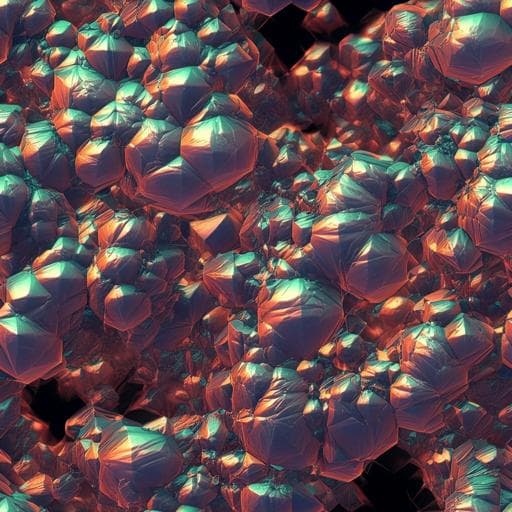
Chemistry
Imaging the microstructure of lithium and sodium metal in anode-free solid-state batteries using electron backscatter diffraction
T. Fuchs, T. Ortmann, et al.
Explore the groundbreaking findings on anode-free solid-state batteries, as researchers including Till Fuchs and Catherine G. Haslam unveil insights into the microstructure of lithium and sodium metals in reservoir-free cells. Discover the dynamic processes at play during electrodeposition and the implications for battery technology.
~3 min • Beginner • English
Introduction
Solid-state batteries promise higher energy density and safety, with major gains expected from lithium and sodium metal anodes. Reservoir-free (anode-free) cells avoid handling reactive metal foils by plating metal onto a current collector during the first charge, increasing energy density and simplifying manufacturing. The key challenge is controlling the morphology and microstructure of plated alkali metal at the current collector–solid electrolyte (CC|SE) interface; while morphology has been studied, the grain-level microstructure (size and orientation) has been unknown. Given the high homologous temperatures of Li and Na at room temperature, potential grain growth during storage is an open question. Electron backscatter diffraction (EBSD) is the most suitable technique to quantify grain size, orientation, and grain boundaries, but requires pristine, flat, passivation-free surfaces, which are difficult for alkali metals. This study establishes an inert, cryogenic-focused ion beam (FIB) + high-sensitivity EBSD protocol to reliably characterize Li/Na foils and electrodeposited films in reservoir-free cells, and investigates how plating and stripping evolve microstructure and how microstructure affects pore formation and anode performance.
Literature Review
Prior work has focused on enabling in situ plating in reservoir-free solid-state batteries and on morphological control via plating protocols, engineered current collectors, seed layers, and stack pressure. Li microstructure in foils can be altered via thermal history, and silver/copper electrodeposits can self-anneal at room temperature, suggesting possible room-temperature grain evolution; however, EBSD studies on Li foils are scarce and none existed for Na or plated alkali metals. EBSD has quantified grain structure in other electrodeposited metals (e.g., Ni, Co–Ni), revealing columnar grains and triple-junction relationships. Passivation layers on Li/Na complicate EBSD due to limited probe depth. Theoretical and experimental studies indicate that microstructure can influence pore formation and plating/stripping homogeneity; vacancy diffusion along grain boundaries is predicted to be fast, potentially affecting void nucleation sites. Overall, despite advances in morphology control and modeling of nucleation/growth at CC|SE interfaces, direct microstructural evidence for plated Li/Na and its evolution during cycling has been missing.
Methodology
- Materials and foil preparation: Commercial Li (99.0%) and Na metals were analyzed as-received (R-Li, R-Na). Microstructure modification was achieved by melting Li at 400 °C and Na at 250 °C, then quenching in liquid nitrogen under Ar to yield quenched foils (Q-Li, Q-Na). Passivation layers were mechanically removed. Fresh foils from quenched ingots were also prepared after storage to assess room-temperature grain evolution. Foil surfaces were cut with a microtome blade at 70° for EBSD.
- Cell configurations for electrodeposition: Three reservoir-free cell types were prepared: Cu|LLZO|Li, SS|LPSCl|Li, and Al(carbon-coated)|NZSP|Na. For garnet-based cells, 10 μm Cu was hot-pressed onto polished LLZO pellets at 900 °C. For LPSCl cells, LPSCl powder (<1 μm) was pressed onto 20 μm stainless steel foil at 400 MPa. For Na-based cells, Al foil was coated with ~1 μm carbon (tape-cast 95:5 carbon:PVDF), then isostatically pressed onto a polished NZSP pellet at 100 MPa. Counter electrodes were Li or Na as appropriate. Stack pressure during deposition: 15 MPa (SS|LPSCl|Li), 5 MPa (Cu|LLZO|Li), 3 MPa (Al|NZSP|Na). Plating current densities: Li at 100 μA cm⁻² (ex situ), Na at 300 μA cm⁻²; pre-plating of ~2 μm Li at 60 °C, 2.5 MPa, 250 μA cm⁻² was used to fix CCs for in situ EBSD.
- Cross-sectioning: Samples were fractured or peeled to expose CC|SE|metal cross-sections. Cross-sections were prepared under cryogenic conditions (−130 °C) using Xe⁺ plasma FIB (30 kV, 0.1–2.7 μA) or alternatively a triple-beam Ar⁺ ion cutter (6 kV, ~2 mA). Sodium samples were cryo-transferred (−160 °C) under inert gas (Leica EM VCT500). Lithium samples were handled cryogenically post-FIB.
- EBSD acquisition: Measurements in a Gemini SEM 560 with Symmetry 3 EBSD detector. Typical conditions: 20 kV, 3.4 nA (partly 10 kV, 12.3 nA for Li). EBSPs processed with AZtec 6.1 and AZtecCrystal. Indexing via Hough transform and dynamic simulated pattern matching; master patterns computed with 2° orientation spacing, followed by orientation refinement and neighbor-based zero-solution replacement; Gaussian filtering for Na maps. Phases considered: cubic Li, Na, Al, Cu; Na₂O/Na₂O₂ considered only to check for misindexing. Grain boundary thresholds: >10° (black), 2–10° (white, Na). Maps provided as inverse pole figure (IPF) in y and x directions as needed.
- In situ EBSD: Cross-sections of Cu|Li|LLZO|Li and Cu|Q-Na|NZSP|Na were contacted in the SEM using micromanipulators. For Li, initial plating at 1,000 μA cm⁻² then −500 μA cm⁻² achieved ~10 mAh cm⁻² (~50 μm). Intermittent EBSD mapping was performed between plating/stripping pauses. For Na, stripping was monitored until pore formation, with voltage transients recorded. Impedance spectroscopy (7 MHz–100 mHz, 10 mV) confirmed nucleation and growth (transition from blocking to reversible metal response).
Key Findings
- Protocol validation: Cryogenic FIB + EBSD produced high-quality Kikuchi patterns on Li and Na foils and cross-sections, with no evidence of microstructural alteration during cryo-FIB. White surface lines seen by SEM generally correspond to grain boundaries.
- Foil microstructures and storage: Thermal processing strongly alters grain size. R-Li grains ~100–300 μm; Q-Li grains ~10–50 μm. R-Na grains approach millimeter-scale; Q-Na ~200–600 μm. No significant grain growth observed during room-temperature storage for days to ~2 weeks in Q-Li or Q-Na, despite high homologous temperatures. Cross-sectional EBSD shows predominantly vertical grain boundaries, attributed to foil geometry and texturing during pressing.
- Electrodeposited film microstructures: Reservoir-free films exhibit large, columnar grains with grain boundaries perpendicular to the CC|SE interface. Grain widths: Li at SS|LPSCl ~20–100 μm; Li at Cu|LLZO ~10–100 μm; Na at Al|NZSP ~10–150 μm. Films differ from foil microstructures (smaller grains, columnar, interface-normal boundaries). For Li at Cu|LLZO, occasional grains do not span the full thickness.
- Electrochemical signatures: Plating shows nucleation overpotentials consistent with literature: Li ~10–20 mV; Na ~80 mV. In SS|LPSCl|Li, a sudden voltage drop indicated dendrite-induced shorting, yet film EBSD remained analyzable.
- In situ EBSD—grain evolution during deposition: During Li deposition at Cu|LLZO, grains coarsen laterally with deposition—initial ~10–30 μm grains merge as grain boundaries migrate laterally, forming >100 μm grains after ~50 μm growth. Grain coarsening occurs during deposition and ceases after plating; no additional growth during 2-week storage. Similar behavior was explored for Na.
- In situ EBSD—pore formation during stripping: During Na stripping at Al|NZSP, pores nucleate and grow predominantly within grains at the metal|SE interface, not along grain boundaries, which remain intact. This is consistent with fast vacancy diffusion along grain boundaries that kinetically suppresses void accumulation at boundaries. Due to EBSD tilt (70°), pore dimensions appear larger; re-polishing confirmed pores were produced by anodic dissolution.
- Interface/texturing effects: No direct replication of CC or SE microstructure in the plated metal was observed; plating on a Li reservoir still produced a columnar, distinct microstructure. Microstructure is dominated by plating conditions (current density, capacity/thickness, pressure) rather than substrate microstructure.
Discussion
The results directly address the unknown microstructure of electrodeposited Li and Na in reservoir-free solid-state cells. EBSD reveals that plated alkali metals form large, columnar grains with boundaries perpendicular to the CC|SE interface, distinct from the larger, more randomly oriented grains in foils. The absence of room-temperature grain growth in both foils and plated films, despite high homologous temperatures, indicates that microstructural evolution is largely confined to the deposition process. In situ EBSD demonstrates lateral grain boundary motion and coarsening during plating, akin to abnormal grain growth or secondary recrystallization, which stops once plating ends. This growth mode explains the observed reduction in grain density with increasing thickness and the presence of truncated V-shaped grains where neighboring grains grow at dissimilar rates.
The discovery that pores nucleate preferentially within grains during stripping, while grain boundaries remain intact, highlights the key role of fast vacancy transport along grain boundaries. This kinetic effect mitigates vacancy accumulation at boundaries, leaving intra-grain regions more susceptible to voiding and loss of interfacial contact—critical for stripping capacity and cycling stability. Consequently, tailoring grain size and boundary density provides a lever to optimize electrochemical performance. Because plated metal microstructure does not mirror CC or SE microstructure, effective control requires tuning deposition parameters (current density, applied pressure, plated capacity) and potentially boundary mobility via impurities or geometric constraints (seed layers, 3D hosts). These insights provide a microstructural basis for interpreting performance improvements reported with seeded nucleation, conductive interlayers, and 3D architectures.
Conclusion
A robust cryogenic FIB–EBSD protocol was developed to quantitatively characterize Li/Na microstructures in foils and buried electrodeposited films. Thermal processing tunes foil grain sizes (Li ~10–200 μm; Na ~200–600 μm), and no significant room-temperature grain growth occurs in Li or Na foils or plated films. In reservoir-free cells (Cu|LLZO|Li, SS|LPSCl|Li, Al|NZSP|Na), electrodeposited films exhibit columnar grains (widths ~10–100+ μm) with boundaries perpendicular to the interface. In situ EBSD shows dynamic lateral grain boundary motion and grain coarsening during deposition that ceases after plating. During stripping, pores form preferentially within grains rather than at grain boundaries, consistent with fast boundary diffusion of vacancies. The plated metal microstructure is governed primarily by deposition parameters (current, pressure, capacity/thickness) rather than CC/SE microstructure, highlighting practical routes to microstructure engineering. Future work should systematically vary current density, pressure, and thickness; explore impurity/seed-layer strategies to modulate boundary mobility; and leverage geometric confinement (3D hosts) to achieve desired grain structures for improved stripping capacity and cycling stability.
Limitations
- EBSD cross-sections sample limited areas; extremely large grains in Na foils sometimes exceeded the field of view, complicating statistical analysis.
- EBSD indexing quality can be reduced by uneven cross-section tilt and interface roughness; some maps exhibited lower indexing rates.
- Pore size/shape in EBSD appears larger due to the 70° tilt; geometric effects may distort apparent pore dimensions despite corrections.
- Systematic parameter sweeps (current density, pressure, thickness) were not exhaustively performed; mechanistic attributions (e.g., abnormal grain growth) require further targeted studies.
- Findings are demonstrated on selected SEs (LLZO, LPSCl, NZSP) and specific CC preparations; generality to other chemistries and architectures warrants further validation.
Related Publications
Explore these studies to deepen your understanding of the subject.







